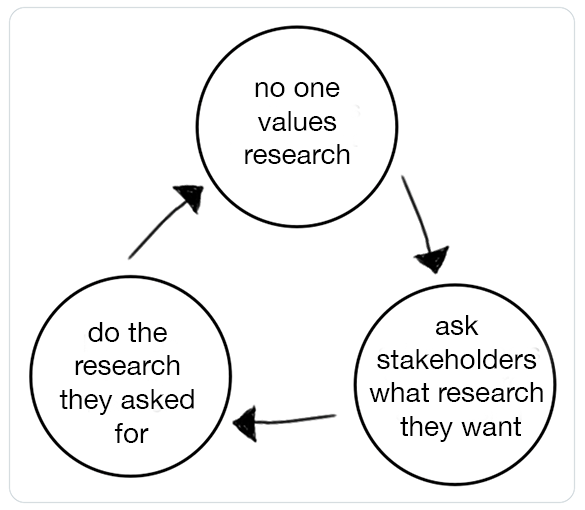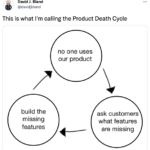Research is a tool for helping companies to move faster with confidence. It identifies potential traps and uncovers new opportunities. Where data analytics can tell us “how many?” and “did it work?”, qualitative research can tell us “why?” and “what next?”
Too often, it doesn’t. When research teams are stuck in the language of usability or delight, it’s a wasted opportunity.
It’s our job to educate stakeholders on the power of research

Most people I work with – even now – associate “user research” with “usability testing”.
I often hear “I’m not ready for research yet”. Upon prodding further, I’ll find out that this stakeholder believes that they need to have testable prototypes ready or a survey to send out.
These are probably the least valuable activities that research can help with. They don’t get us a seat at the table. (They’re not worthy of a seat at the table.)
Giving clear examples is a great first step.
You can bring us questions like:
- I’m not sure how customers think about X / what their mental model…
- I can see usage data but I’m not sure why customers are behaving this way…
- My team isn’t quite aligned on who our target customer is…
- Are these assumptions around user motivations accurate?
- We’d like to understand more about how customers use [competitor]…
Giving those examples is necessary but not sufficient.
The next step is that, as researchers, we need to eavesdrop and interrupt.
We need to skim docs and chat rooms and listen in on meetings until we hear some of those unchallenged assumptions and unsolved customer mysteries, and then volunteer to seek out answers. It’s great if stakeholders jump in and collaborate on that research; and even if they don’t, we aren’t asking for permission.
Our job is not to convince others of the value of research – it’s to create value through uncovering information that can change minds.
We need to say no to ‘bad research’
When research is fighting to contribute to the most critical business areas, it’s natural that we’d want to be helpful in the meantime. So we agree to do usability testing or moderate focus groups. We help peers ask customers “which design do you prefer?”, knowing that a static mockup won’t reveal much about how an interactive flow will fit into that person’s workflow.
All this does is strengthen the association between research and nice-to-have, non-influential activities. It firmly fixes in stakeholders’ minds that research is optional and centered around the intangible “user experience” rather than being a critical business advantage.
—-

⬅️ If you don’t recognize the reference in the title, I’m riffing off this image.
It illustrates the vicious cycle that happens when product folks take customer requests at face value.
The more “it seemed like a good idea but actually didn’t solve a root problem” features we build, the objectively worse our product becomes.

